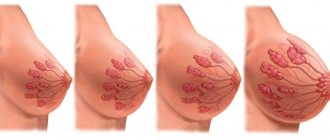It so happens that an absolutely healthy baby does not want to “join” natural feeding, causing bewilderment and anxiety among new parents.
What does it look like? In some situations, the child simply does not take the breast into his mouth, and no tricks work. It happens that the baby attaches to the breast, makes a couple of sucking movements, and with irritation and dissatisfaction arches, moving away from the mother. Sometimes refusal occurs dramatically: the child not only does not take the breast, he also freaks out, bends over, and sobs bitterly. A special case is the refusal to drink milk from a particular breast, when the baby willingly sucks, for example, from the left mammary gland, without showing any desire to “try” the right one. In the case of older children, there are often situations when the baby bursts into tears and screams at the very sight of her mother’s breast.
A nursing mother does not always understand the reason for breastfeeding. The versions are very different: from lack of milk to the painful condition of the child. Why does this really happen?
Why does a child refuse the breast?
All possible reasons for refusal are divided into two large groups: psychological and physical. Psychological reasons lead to the so-called false refusal of breastfeeding. In this case, the child does not experience physical conditions that would interfere with the process of natural feeding. We are talking about internal anxiety, which is expressed in this form. If there are physical reasons, we are talking about true breast refusal, when the baby experiences physical difficulties when trying to get enough milk.
The child refuses for psychological reasons
Resentment, fear, psychological trauma
A newborn has a strong emotional contact with his mother, who is practically his whole world and source of life. Situations when this emotional contact is disrupted and the baby begins to feel detached, abandoned by the mother, and even worse, threatened or uncomfortable by her - this is a very real threat to the continuation of natural feeding. What can cause such stress in a baby?
Frequent absences and prolonged absence of a nursing mother
Naturally, the mother leaves the baby at such an early age for various reasons, sometimes very objective. A woman may get sick and end up in the hospital. Sometimes circumstances force a young mother to immediately go to work. No matter what good intentions this is done, for a child the absence of a mother is extremely stressful , because the baby spent most of his life in symbiosis and close connection with a woman. Separation and perception of the mother as a separate person occurs gradually, so for the baby, separation from her mother is tantamount to separation from part of her own body.
Insufficient body contact
It happens that a woman does not leave home for a long time, but does not give the baby enough of her close presence and affection. This often happens under pressure from “authoritative” friends and relatives: “Don’t carry it in your arms all the time - you’ll get used to it!”, “You’ll break your back!”, “They’ll ride on you!” A young mother will hear all sorts of recommendations. But it is worth considering that for a baby the need for frequent and close physical contact is not a whim or a whim. At first, bodily sensations are the main source of information about the world, and mother’s scent, heartbeat and warm hugs are the most beautiful and desirable. Children who are left alone for a long time, not held or caressed, may not only refuse to latch on to the breast, but also lag behind in development.
Unpleasant manipulations
This reason is the scourge of “advanced” parents who thoughtlessly strive for early comprehensive development and education of a “superman”. When a baby is subjected to unpleasant manipulations, he experiences discomfort and a desire to move away from the source of discomfort (the mother). After all, all these stressful situations occur with the permission (and more often with the active participation) of the beloved mother, who previously protected the child from all adversity. Hardening in cold water and similar procedures may not lead parents to the result they expect. If the baby is not ready to stay in extreme conditions and experiences active discomfort, it is quite possible that he will begin to refuse the breast.
Don't try this at home!
“Regular” approach to organizing feeding
A relic of the Soviet era is still alive in the memory of previous generations. Along with advice on tight swaddling, today's mothers are given the "valuable" experience of feeding "by the hour" - for example, offering the breast every three hours during the day with a six-hour break for sleep at night. This is probably convenient for the mother - in such a situation it is easier to manage her time. But what does the unfortunate baby experience, who, for some unknown reason, is being taught to a certain regime? The most compassionate ones allow you to offer water during the mandatory breaks, while others advise distracting. These are outdated ideas with traumatic consequences for the child’s psyche (and, sometimes, health). Adherents of such a system argue with nature and refuse to satisfy the basic needs of satisfying hunger and thirst of a helpless child. Remember that in the mother’s belly the baby received nutrients (= ate) 24 hours a day, so the transition to “intermittent” feeding through the mouth outside the mother’s belly is already stressful for him. There is no need to make it worse. According to current WHO recommendations, a child up to 6 months should be fed on demand.
Overexcitement from excess impressions
In the process of development, the child is rebuilt from internal to external perception. This is a natural process of psychological restructuring. A huge unknown world opens up before the baby, full of new impressions and evoking a variety of emotions. In the course of learning, a small person spends a lot of mental and physical strength. This is also stress, which leads to overexcitation of the nervous system during wakefulness. The baby is simply distracted by exploring the world, forgetting that he is hungry, and therefore refuses to take the breast. Please note that at night and around dreams the baby usually suckles without problems.
Solutions to other problems associated with breastfeeding can be found in our special project “Breastfeeding from A to Z”
Causes of physical failure
In case of true breast refusal, you need to look for a material reason - a painful condition, a physical difficulty or obstacle.
Using pacifiers and pacifiers
All kinds of mother’s “helpers” that can calm a crying baby or facilitate the process of supplementary feeding or supplementing from a bottle are not always compatible with the process of breastfeeding. A pacifier, which is offered to a baby between feedings, satisfies the sucking reflex, but nature has not invented such “technical devices.” The child satisfied his needs during the feeding process. In addition, the shape of even the most physiological nipple or pacifier is not similar to the breast, and in the process of sucking the baby gets used to making efforts of a different nature, placing his lips and tongue differently. In the future, this can lead to breast refusal. In the case of bottles, there is another aggravating factor: less effort is needed to get milk through the nipple. If the baby understands this, then natural feeding will be in jeopardy. For more information about when you should use a pacifier and when it is best to avoid it, read the article The benefits and harms of pacifiers
Physical illness
Colic: When the tummy is bloated, the baby cannot concentrate on sucking, even if he is very hungry. Runny nose: During the first six months of life, a newborn is only able to breathe through the nose. In addition, a child's nasal passages are very narrow and tend to close very quickly if the mucous membrane swells or discharge appears. A runny nose interferes with breathing, particularly during feeding. Thrush in the mouth: the development of a fungal infection in the baby’s mouth causes discomfort during sucking. If the baby abandons the breast and is capricious, check if there are whitish areas with a cheesy coating on the mucous membranes. Otitis: If your little one's ears hurt, feeding hurts. The baby has short ear canals, and during sucking, a vacuum is formed in the oral cavity, which causes pain in the ears.
Incorrect attachment as a cause of failure
Inexperienced mothers often have no idea that their child is refusing to breastfeed because their feeding process is not organized correctly. If the baby only latches onto the nipple, there will be no milk. To activate the milk supply process, you need to squeeze the areola. In this case, the mouth should be wide open, and a vacuum should form in the oral cavity. Read more in the article about proper breastfeeding.
Milk flow too strong/weak
If the breast is full and the baby is below the level of the mammary gland, then during feeding the milk may flow excessively abundantly and actively. The baby will choke. In the opposite situation, when there is not enough milk in the breast, or the woman is tense, the baby makes incredible physical efforts to suck out the fluid. In both situations, the baby may begin to refuse, and both need correction.
LACTATION CRISIS. A lactation crisis is a certain stage of feeding, usually corresponding to a growth spurt in a baby, when the amount of milk in the mother has not yet adjusted to the new needs of the child. The first lactation crisis usually occurs in the third month of a child’s life. This is a separate case, and read about it in a separate article.
All of the above reasons for refusal can be eliminated with a competent approach. To restore natural feeding, it will take 1-2 weeks, and compliance with the recommendations appropriate to the situation.
Such different children
One fine day, a nursing woman discovers unusual changes in the behavior of her newborn baby. The child suddenly becomes whiny, capricious, refuses to breastfeed and becomes irritable. If the baby’s age at this moment has reached 3 months, then we can safely talk about the development of false breast refusal.
Such behavior on the part of a baby can cause a storm of indignation among young mothers. False refusal to feed is a variant of the norm, so a conscious and correct approach to solving this issue will allow you to quickly cope with the problem without causing serious consequences.
When a newborn baby reaches three months of age, changes occur in his body that are directly related to knowledge of the outside world and adaptation to its conditions.
A three-month-old baby is very receptive to the information around him, so the usual feeding regimen causes a natural protest in the baby.
- Despite the fact that the child strives to learn about the world around him as quickly as possible, his natural needs for eating food do not disappear.
- The main sign of this condition is the child’s increased attention to everything around him and whims caused by the need for food. Due to lack of experience, some young mothers perceive this phenomenon as the child’s reluctance to drink mother’s milk.
- This thought pushes the parent to transfer the baby to artificial milk formula. Similar situations arose several decades ago, when women, seeing the dissatisfaction of their newborn child, preferred to transfer him to feeding with milk formula or semolina porridge.
The true reason for a child’s false refusal to breastfeed is those age-related changes in the child’s body that occur as they grow older. The baby's need to explore everything that surrounds him increases, so the next attempt to attach him to the breast is perceived by the baby as something distracting and annoying.
This situation is completely physiological, so to combat it, a young mother only needs to reconsider her behavior and take certain measures. Newborn children under the age of 1 year are faced with pathological factors that lead to refusal to breastfeed.
No one argues that mother's milk is the best food for a baby. They only argue about how much a baby should breastfeed in order to grow up physically and mentally healthy.
Previously, in Soviet times, they tried to transfer the baby to artificial feeding as early as possible, because a Soviet woman should work and not run home to feed the child. So now we read in books from grandmother’s bookcases: “At 6 months, breastfeeding continues only optionally, depending on the instructions of the pediatrician...”.
Nowadays, feeding up to a year is considered the norm, although at this age weaning rarely takes place without children's tantrums and demands from the baby. Isn't it because it's early? After all, the mother’s breast is not only food (a one-year-old child is quite full of “adult food”), but also mother’s love, and also protection from diseases and fears, stress and pain... So the 12-14-24-30-month-old baby clings to mother’s breast, as the basis of the world, for something unshakable, reliable.
That’s why it’s funny for me to hear mothers sometimes say: “But mine gave up breastfeeding at 5 months - he no longer needed it...”. How is this possible?! Let's put psychology aside. Let's return to physiology. Man is an animal (don’t gasp or sigh: he’s smart, cunning, but an animal is not a plant :-). Animals live in nature.
They don’t receive maternity pay, they don’t go to the store to buy jars of puree, they don’t wean their babies until they can take food THEMSELVES and eat it. How can a 5 month old baby do this? But a one-and-a-half-year-old baby is quite capable of climbing onto the table and eating all the potatoes from his dad’s soup while he runs off to the TV.
Okay, let’s assume that I’ve persuaded you, and you’ve firmly decided to feed your baby for up to a year, or even 2-3. Let's move on to the most important thing - the reasons for a child's refusal to breastfeed and ways to overcome difficulties. I conditionally divided them into two groups: physical and psychological. Why conditional? Yes, because sometimes it is difficult to determine which group of problems a given one belongs to. Moreover, as a rule, refusal occurs for several reasons at once. But first I would like to write a little about the characteristics of children.
Our children, like all adults, have different temperaments from birth. Some of them cannot be harmed by anything, they look at the world philosophically, confidently suck on their mother’s breast, and after that they sleep soundly. And others... screaming, crying - someone looked wrong, yelling - mom speaks louder than usual, shuddered - something fell. Some, if something doesn’t work out, continue to try again and again, while others, as soon as things don’t work out, give up everything and sit down to cry.
Calm and nervous, persistent and lazy suckers, sleepyheads and vigorous ones, strong and weakened. Such different babies... It is clear that breastfeeding will develop differently for such babies. So, after reading about “what could happen”, do not be alarmed - it is not necessary that any of the above will lead to a refusal of breastfeeding.
It is also worth knowing that failure can be short-term and persistent. Short-term: “Mom smells unusual. I won’t suck.” And as soon as mom takes a swim, everything gets better. But if this is repeated constantly, the failure may become persistent, and then in order to return full-fledged breastfeeding, much more effort will be needed.
What to do if the baby wants to eat, but does not want to breastfeed?
Elimination of psychological causes
We feed on demand
If your baby is stressed by the “regime” style of feeding, it is important to restore trust and understanding that the breast is available at any time.
- Offer the breast to your newborn half hour to hour.
- For a baby up to 4 months , this period is 1-1.5 hours. In general, if your baby hasn't slept for 2 hours, encourage him to snuggle hourly.
- Children over 4 months should be applied every 2 hours
Feeding with “white noise”
“White noise” is a monotonous background sound of varying intensity and frequency. Similar sounds are produced by a radio on an empty frequency, a waterfall or water flowing from a tap, a running hair dryer, a vacuum cleaner or a fan. In “white noise” conditions, babies stop getting irritated and worried, often calm down and fall asleep. Why is this happening? The memory of intrauterine life is triggered, when the child was constantly surrounded by physiological sounds of the body caused by the work of the stomach and intestines, heartbeat and blood flow in the great vessels. Over nine months, the baby gets used to these background (and quite loud) sounds, and “white noise” has a calming effect. Try feeding your baby to the sound of running water (or turn on a white noise recording) and you will see that he no longer refuses to breastfeed.
White noise for babies
Ocean sounds for baby's sleep
Feeding in the dark
Dimmed or absent lighting has a calming effect on the newborn , because the stomach was also not very light. The lack of light combined with rocking can put the baby into a half-asleep state, when it will be easier to offer the breast and achieve sucking.
Restoring trust
If the child begins to refuse breastfeeding due to resentment towards the mother, then it is worth providing the baby with enough attention from the mother:
- Try to spend all your time in close physical contact with your child.
- Establish co-sleeping (use extreme caution)
- Give up the stroller for a while and carry your baby in a sling
- Practice skin-to-skin contact - place the undressed child on top of you during sleep, bathing, and communication.
- Choose moments of maximum calm for feeding, when the baby has just woken up or is starting to go to sleep.
Nesting method
This is the most effective, but also the most difficult method , which is recommended for restoring breastfeeding after psychological trauma. What should be done? First of all, ensure constant close physical and emotional contact with your mother. During the nesting period, the presence of any other people must be excluded from the baby’s life. For several days, the mother stays in a quiet, darkened room with the child. Most of the time is spent in bed next to the baby. The mother lying nearby constantly offers the baby her breast, without being distracted by any other concerns. Even if the baby is sleeping or not hungry, try not to be away for more than a few minutes. Such close spending time will allow the baby to constantly feel the presence of the mother and restore trust. Agree that during this period your loved ones take care of all household chores.
Too fatty milk
Due to physiological characteristics, human milk comes in two types. At first, less high-calorie milk is released, more liquid, but no less healthy. It is easy to drink, since the consistency is watery, and the child does not need to make a lot of effort. This type of milk is followed by another, thicker and higher in calories. Some babies stop sucking the moment the change occurs. The fact is that resorption requires a lot of strength, which the baby may not have or may simply be lazy.
How to help your baby refuse breast milk:
- Massage your mammary glands before and during feedings
- Feed your baby from both the left and right breast so that he can suck more foremilk
- Review your diet. It happens that milk becomes excessively fatty due to the fact that the mother abuses dairy products or nuts
- The mother should drink at least 2 liters of liquid per day so that the milk is sufficiently liquid
Eliminating physical causes of failure
We treat ailments
If you suspect that breast refusal is caused by a painful physiological condition (there are other symptoms), contact your pediatrician . It is important to establish a diagnosis and carry out therapy as soon as possible.
We refuse any breast substitutes
The first thing to do if your baby stops latching is to remove any pacifiers and nipples . With a pacifier the situation is simpler: the sucking reflex is satisfied during feeding. If your baby needs to be fed or supplemented with water, do not use a bottle. Use a spoon or a plastic syringe (without a needle), try using a sippy cup.
We apply it correctly
When attaching your baby, make sure that:
- the head is not thrown back or turned to the sides, the chin is not pressed to the chest;
- the mouth is wide open so that in the grasping position the lips are turned outward, and dimples form on the cheeks during sucking;
- baby grabbed the areola, not the nipple
- To start feeding, bring the nipple to the corner of your mouth. The baby will reflexively open his mouth and turn towards the chest
Changing the feeding position when there is abundant milk production
If the baby is choking while trying to latch onto a breast that is full of milk, change the position so that the breast is lower than the baby's head during feeding. Try placing your baby on top of your chest while lying on the bed. Make sure that the baby's nose is not covered by the mammary gland. Also, express some of the milk before feeding.
Stimulating milk production during weak lactation
If your baby refuses to breastfeed because he has to exert too much force to suck the milk, try to relax as much as possible before feeding. Take a warm shower, thinking about the upcoming communication with your baby. Massage your breasts in the direction of the milk flow. Try massaging your breasts a little before feeding to stimulate more active milk production and flow. You can also feed in an overhang position so that gravity helps your baby suckle.
Mistakes when attaching your baby
In order for milk to flow in sufficient quantities, the baby must hold not only the nipple, but also the areola in his mouth. If the latch does not occur correctly, the baby remains hungry, as evidenced by poor weight gain and frequent crying of the baby.
See also:
The drug bromocriptine to stop lactationCessation of lactation
How to transfer a child from breastfeeding to artificial feedingCessation of lactation
How to wean a child from breastfeeding correctly Termination of lactation
How to teach a baby to suck properly? To do this, you should follow these rules:
- Start feeding when baby is calm and not crying
- For a softer areola, lightly pump your breasts before breastfeeding.
- It is advisable to lubricate the areola and nipple with milk, press with your fingers for better grip on the nipple, then offer the child to eat
- While sucking, make sure that the baby does not stop holding the areola in his mouth.
Is supplementation necessary when weaning?
The decision on the need for additional feeding should be made together with the pediatrician who has been monitoring the child since birth. Focus on weight gain or loss. Additionally, you can do a diaper test at home.
Diaper test
A simple method to determine whether your baby is getting enough nutrition. During the day, do not put disposable diapers on your child; use only cotton diapers or onesies. If after 24 hours there are at least 12 wet items, then there is no cause for concern - the child receives enough food and drink.
If the result does not live up to expectations, the child will have to be supplemented with formula. However, do not stop breastfeeding under any circumstances. Supplement your baby with a spoon or syringe. You can also use a pipette or purchase a special SNS system.










